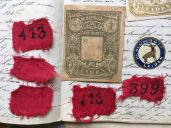Step 6 of 14
Dyeing: Seeing Red
Step number four. After the fabric is all tied up, the dyeing begins. The fabric is tied in half so that the edge and the centre will be different colours when unfolded.
Red is the first, and arguably the most important, colour. Throughout his lifetime, Driessen sought to perfect the colour red that was used in Indonesian dyeing practices. Sample books are full of his experiments with rich variations on the colour red.
In Indonesia, red symbolises the world of the living – beginning with pale pinks to show birth and youth, then growing darker to represent ageing. Colour communicated different things about the wearer and to the Javanese community, so the shades of dye had to be precise and consistent across a cloth.


